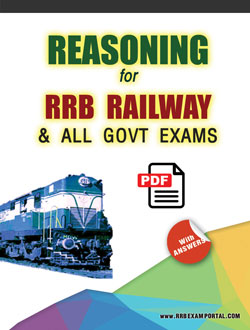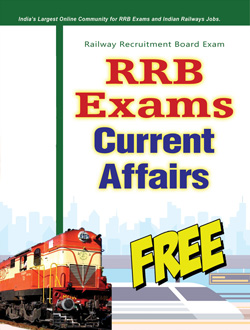Study Material For RRB Exam: General Knowledge (G.K.) - History: Ancient India
Study Material For RRB Exam - General Knowledge
Section : History
The Indian History is perhaps the oldest in the world, and the sources of Indian History are the verbal history, because our ancients never did bother about putting things down on paper and archaeological evidences. Based on the evidences available today, Indian History, like the history of every ancient culture in the world, is broadly divided into four periods as mentioned below:
Pre-History
Ancient History
Medieval History
Modern History
ANCIENT INDIA
The discovery of Mohenjodaro and Harappa by British archeologist: Marshall proved that Indian civilization is the oldest civilization in the world. Even India came before Greece, considered the oldest civilization before the discovery of Mohenjodaro and Harappa. The main features of Ancient Indian History are as follows:
Indus Valley Civilization
Discovery: In 1921, R.B. Dayaram Sahani, first discovered Harappa, in the Montgomery district of the Punjab. According to radio-carbon dating, it spread from the year 2350-1750.
The Vedic Period (1500 Bc-600 Bc)
Initially, they settled in the area of Sapt-Sindhu, which included Punjab, Kashmir, Sindh, Kabul and Gandhara (Kandhar). The chief sources of this period are The Vedas and the Epics, the Mahabharata and the Ramayana, which through their stories PO and hymns tell us about the expansion of the Aryans. The epic Ramayana is a symbolic tale which tells of the Aryan expansion to the south-the good, almost godly, aryaputra (an Aryan’s son) king Rama surging forth to finish off the evil Dasyu (that was what the Aryans called the natives) Ravana.
Buddhism
Buddhism founded by Gautam Budha or Siddharha.
-
The Buddha also known is Sakyamuni or Tathagata.
-
Born in 563 BC on the Vaishakha Poornima day at Lumbini (near Kapilavastu), in Nepal
-
His father Suddhodana was the Sakes ruler.
-
His mother (Mahamaya, of Kosala dynasty) died after 7 days of his birth, brought up by stepmother Gautami.
-
Married at the age of 10 to Yoshodhara. Enjoyed the married life for t 3 years and had a son named Ralula.
-
After seeing an old man, a sick man, a corpse and an ascetic. he decided to become a wanderer.
-
Left his palace at the age of 29 in search of truth (also called Mahabhinishkramana’ or the Cheat Renunication) and wandered for 6 years.
-
Attained ‘Enlightenment’ at Gaya in Magadha (Bihar) under the Pipal tree.
-
Delivered the first sermon at Samath where his five disciples had settled. His first Sermon is called ‘Dharmachakrapracartan’ or ‘Turning of the Wheel of Law’.
-
Attained Mahaparinirvana at Kushinagar (identical with village Kasia in Deoria district of UP), in 483 BC at the age of 80 In the Malla republic.
Buddhist Councils
-
First Council: At Rajgriha, in 483 BC under the Chairmanship of Mehakassaapa (king was Ajatshatru). Divided the teachings of Buddha in to two Pitakas- Vinaya Pitaka and Sutta Pitaka.
-
Second Council: At Vaisahali, in 383 BC under Sabakami (King was Ashoka), followers divided into Sthavirmadins and Mahasanghikas.
-
Third Council: At Pataliputra, in 250 BC under Magaliputta Tissa (King was Ashoka) In this, the third part of the Tripitaka was coded in the Pali language.
-
Fourth Council: At Kashmir (Kundalvan) in 72 AD under Vasumitra (King was Kanishka, Vice-Chairman was ashwaghosha), divided Buddhism into Mahayana and Hinayana sects.
-
Buddist Literature: In Pali language.
-
Vinaya Pitaka: Rules of discipline in the Buddhist monasteries.
-
Sutta Pitaka: Largest, contains collection of Buddha’s sermons.
-
Abhidhamma Pitaka: Explanation of the philosophical principles of the Buddhist religion.
Jainism
-
Led by Rishabha.
-
There were 24 Tirthankaras (Prophets or Gurus), all Kashtriyas. First was Rishabhnath (Emblem: Bull).
-
The 23rd Tirthankar Parashwanath (Emblem: Snake) was the son of King Ashvasena of Banaras.
-
The 24th and last Tirthankar was Vardhman Mahavira (Emblem: Lion). He was born in kundagram (Distt Muzaffarpur, Bihar) in 599 BC.
-
His father Siddhartha was the head of Jnatrika Clan.
-
His mother was Trishla, sister of Lichchavi prince. Chetak of Vaishali.
-
Mahavira was related to Bimbisara.
-
Married to Yashoda, had a daughter named Priyadarsena, whose husband Jamali became his first disciple.
-
At the age of 30, after the death of his parents, he became an ascetic.
-
In the 13th year of his asceticism (on the 10th of Vaishakha), outside the town of Jrimbhikgrama, he attained supreme knowledge (kaivalya).
-
From now on he was called Jaina or Jitendriya and Mahavira, and his followers were named Jains. He also got the title of Arihant, i.e., worthy.
-
At the age of 72, he attained death of Pava, near Patna, in 527 Bc.
-
Mahavira preached almost the same message as Parshvanath and aded one more, Brahmcharya (celibacy) to it.
Magadh Empire
Harijanka
The first important Magadhan king, who emerges into the limelight was Bimbisara (544491 BC) of the Harijanka. He was an extremely polished diplomat and crafty statesman. While the earlier rulers had brought Magadha out of clear and present danger, it was Bimbisara, who consolidated and increased that power and really gave it the identity of a kingdom. According to sources, eighty thousand villages were there in the kingdom. Bimbisara was a contemporary of the Buddha and met him twice.
Shishunanja Dynasty
The Shishunanja dynasty faded fast after Ajatsatru. The last recorded ruler of the family was Kakavarna who was put to death by Mahapadmananda, of the Nanda dynasty, which followed the Sisungas. The Nandas known for their airs of magnificence and immense wealth (which they amassed by huge taxation). They were of lowborn sudra stock and hence had the odds stacked against them right from the start.
Alexander Invation (Great Invation)
Alexander, the son of Phillip of Macedonia (Greece), invaded India in 326 BC. His major battle was with Poras, the king of Panjab on the banks of river Jhelum. Alexander emerged victorians.
Mauryan Dynasty (321 Bc-185 BC)
The dynasty that Chandragupta and Chanakya established in Magadha together, was the first real dynasty of Indian history. There is no certain theory about the lineage of Mauryas. One of the most prominent theory was that he was actually the son of Dhanananda mistress called Mura, and hence the name Maurya.
Whatever might be the lineage of Chandragupta Maurya, Chanakya, with him made a formidable team and stayed together till the end of Chandragupta’s reign, when Chanakya lived to see the early half of his successor Bindusara’s (298-273BC) reign too. There is sufficient evidence to prove that elaborate planning and much intrigue went to shake the Nandas out of the Magadha throne.
Ashoka the Great
Ashoka Piyacassi Maurya (269-232 BC) was perhaps Buddhism’s most famous convert. He has caught the imagination of many as the cruel king who suddenly, after one battle, saw the light and became an avowed non-violent though he did put all his brothers to death to come to the throne, but then that was no different from what any other aspiring king would have done, and no doubt any of his brothers in similar circumstances would have done the same.
The Post-maurya Period
In the post-Maurya period, three dynasties jostled, came and
went with astonishing speed on the Magadhan throne. The first among these were
the Sungas, under whom the country made certain The Post-maurya Period
In the post-Maurya period, three dynasties jostled, came and went with
astonishing speed on the Magadhan throne. The first among these were the Sungas,
under whom the country made certain progress. The Sunga rulers were also quite
successful in checking foreign invasions. Art and culture also flourished
considerably under the Sungas who were particularly known to be great patrons of
both.
The Sungas were followed by the Kanvas, who were almost like a blip in the scene of Indian history, lasting only 45 years in all, The other important dynasty of this PostMauryan confusion was the Andhras or the Satavahanas. According to traditional sources, they were apparently Dasyus (as opposed to Aryans) from south India. Even in Ashoka’s time, this dynasty had risen to quite a bit of prominence along the southwest regions. Though the dynasty was founded by Simukha (235-213 BC), it had 30 kings in all. One of the most famous rulers of this dynasty was Sri Satkarni (194-184 BC), who had a kingdom covering almost all of south India, down to the andhra region and around with his capital as the present Aurangabad.
Gupta Dynasty
After the Kushanas, India saw political unity only under the second great dynasty of ancient Indian history after the Mauryas, the Guptas. The imperial Guptas were great conquerors, efficient administrators and renowned patrons of the arts, science and culture.
Great Rulers of Gupta Dynasty
The first Gupta king was Chandra Gupta (320-335 AD), though not much is known about him. Next in line was Samudragupta (335-375 AD) who, by all accounts, seemed to have been nothing short of a genius. He appears to have cone to the throne brimming with an amazing appetite for conquest, Considering that he defeated kings all over northern and southern India (in all about twenty-four of them) one wonders when did he get the time to govern the kingdom. He introduced the concept of annexation. It meant that he retained the old kings as vassals to keep the administration going. He was a skillful diplomat who had excellent relations with not only foreign rulers but also his vassal-kings, surely a much more difficult task to achieve, Due to his ingenious ideas of government, Samudragupta could establish a really powerful empire.
Vardhana Dynasty
The final important ruler of Ancient Indian history was Harsha Vardhana (606-646 AD), who ruled not from Magadha but Thanesar (in modern Haryana area) of the Vardhana dynasty. He was a Buddhist and convened many Buddhist assemblies. The second Chinese traveller to come to India, Huien Tsang, arrived during his reign.
Other Dynasties
The Most Powerful Cholas
The most important dynasty to rise out of the southern India was Cholas. Unlike other dynasties (the Chalukyas, the Pallavas, the Pandyas or the Rashtrakutas), their origins are not traced from outside, but very much from the south itself. The Deccan region was at this time in much turmoil. The Cholas had managed almost immediately to reduce the Pallavas to the status of minor feudatories. The Rashtrakutas were in decline now, but their place was taken by the Chalukya family (imaginatively called the later Chalukyas by historians), who were gaining strength in the region of western Deccan. The power equation in the Deccan now involved the later Chalukyas, the Yadavas of Devagiri (northern Deccan; region around Aurangabad), the Kakatiyas of Warangal (Andhra Pradesh) and the Hoysalas of Dorasamudra (Mysore). The Cholas managed with sheer tenacity over a period of 300 years from 900-1100 AD. This period saw the final settling down and consolidation of Tamil culture. In whatever spherewhether of social institutions, religion, fine arts, music, dance, jewellery, the standards that were set during this period came to be regarded as classical, and dominate, in a modified form, much of the living patterns of south Indians even today.





